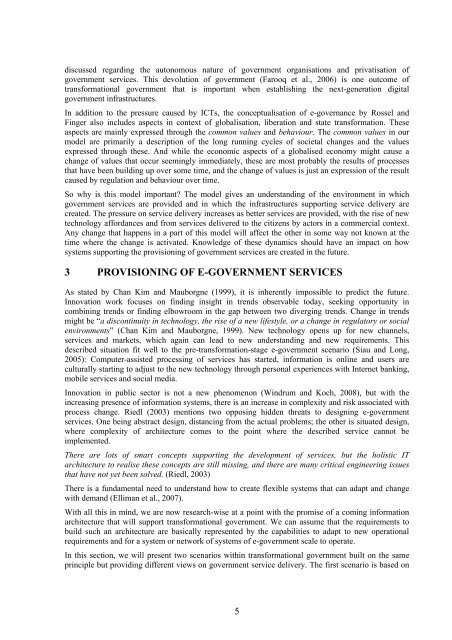Multi-channel provisioning of public services - Department of ...
Multi-channel provisioning of public services - Department of ...
Multi-channel provisioning of public services - Department of ...
Create successful ePaper yourself
Turn your PDF publications into a flip-book with our unique Google optimized e-Paper software.
discussed regarding the autonomous nature <strong>of</strong> government organisations and privatisation <strong>of</strong><br />
government <strong>services</strong>. This devolution <strong>of</strong> government (Farooq et al., 2006) is one outcome <strong>of</strong><br />
transformational government that is important when establishing the next-generation digital<br />
government infrastructures.<br />
In addition to the pressure caused by ICTs, the conceptualisation <strong>of</strong> e-governance by Rossel and<br />
Finger also includes aspects in context <strong>of</strong> globalisation, liberation and state transformation. These<br />
aspects are mainly expressed through the common values and behaviour. The common values in our<br />
model are primarily a description <strong>of</strong> the long running cycles <strong>of</strong> societal changes and the values<br />
expressed through these. And while the economic aspects <strong>of</strong> a globalised economy might cause a<br />
change <strong>of</strong> values that occur seemingly immediately, these are most probably the results <strong>of</strong> processes<br />
that have been building up over some time, and the change <strong>of</strong> values is just an expression <strong>of</strong> the result<br />
caused by regulation and behaviour over time.<br />
So why is this model important? The model gives an understanding <strong>of</strong> the environment in which<br />
government <strong>services</strong> are provided and in which the infrastructures supporting service delivery are<br />
created. The pressure on service delivery increases as better <strong>services</strong> are provided, with the rise <strong>of</strong> new<br />
technology affordances and from <strong>services</strong> delivered to the citizens by actors in a commercial context.<br />
Any change that happens in a part <strong>of</strong> this model will affect the other in some way not known at the<br />
time where the change is activated. Knowledge <strong>of</strong> these dynamics should have an impact on how<br />
systems supporting the <strong>provisioning</strong> <strong>of</strong> government <strong>services</strong> are created in the future.<br />
3 PROVISIONING OF E-GOVERNMENT SERVICES<br />
As stated by Chan Kim and Mauborgne (1999), it is inherently impossible to predict the future.<br />
Innovation work focuses on finding insight in trends observable today, seeking opportunity in<br />
combining trends or finding elbowroom in the gap between two diverging trends. Change in trends<br />
might be “a discontinuity in technology, the rise <strong>of</strong> a new lifestyle, or a change in regulatory or social<br />
environments” (Chan Kim and Mauborgne, 1999). New technology opens up for new <strong>channel</strong>s,<br />
<strong>services</strong> and markets, which again can lead to new understanding and new requirements. This<br />
described situation fit well to the pre-transformation-stage e-government scenario (Siau and Long,<br />
2005): Computer-assisted processing <strong>of</strong> <strong>services</strong> has started, information is online and users are<br />
culturally starting to adjust to the new technology through personal experiences with Internet banking,<br />
mobile <strong>services</strong> and social media.<br />
Innovation in <strong>public</strong> sector is not a new phenomenon (Windrum and Koch, 2008), but with the<br />
increasing presence <strong>of</strong> information systems, there is an increase in complexity and risk associated with<br />
process change. Riedl (2003) mentions two opposing hidden threats to designing e-government<br />
<strong>services</strong>. One being abstract design, distancing from the actual problems; the other is situated design,<br />
where complexity <strong>of</strong> architecture comes to the point where the described service cannot be<br />
implemented.<br />
There are lots <strong>of</strong> smart concepts supporting the development <strong>of</strong> <strong>services</strong>, but the holistic IT<br />
architecture to realise these concepts are still missing, and there are many critical engineering issues<br />
that have not yet been solved. (Riedl, 2003)<br />
There is a fundamental need to understand how to create flexible systems that can adapt and change<br />
with demand (Elliman et al., 2007).<br />
With all this in mind, we are now research-wise at a point with the promise <strong>of</strong> a coming information<br />
architecture that will support transformational government. We can assume that the requirements to<br />
build such an architecture are basically represented by the capabilities to adapt to new operational<br />
requirements and for a system or network <strong>of</strong> systems <strong>of</strong> e-government scale to operate.<br />
In this section, we will present two scenarios within transformational government built on the same<br />
principle but providing different views on government service delivery. The first scenario is based on<br />
5
















